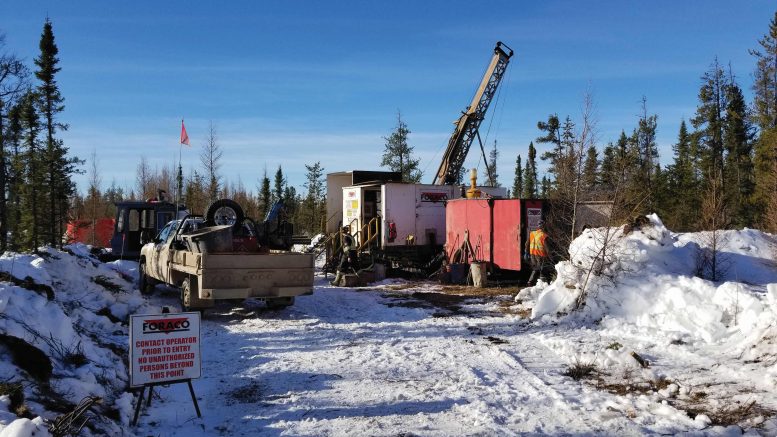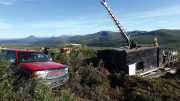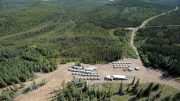Just three days after Osisko Metals (TSXV: OM) closed the $34-million acquisition of Pine Point Mining, it announced it had kicked off a 50,000-metre drill program at the historic Pine Point zinc-lead property, 65 km east of Hay River, Northwest Territories.
“We knew right away we wanted to convert Pine Point’s historical resources to National Instrument 43-101 compliant resources — that’s why we started so quickly,” Osisko Metals president and CEO Jeff Hussey says.
“The first phase of drilling is 50,000 metres. That’s a minimum that this camp needs because there are so many deposits — we’re looking at 40 to 46 different historical deposits.”
Osisko Metals collaborated with the previous owner to get moving as soon as possible, drilling 7,500 metres over the winter of 2018, and focusing on areas with poor summer access. Assays are pending from this part of the program.
Right now, the company is preparing to resume drilling at Pine Point, following the spring breakup. It has three drill rigs on-site and looks to add more this season.
Hussey says the 50,000 metres will consist of at least 500 shallow holes. “That’s the beauty of Pine Point: the historical resources are between 50 and 100 metres’ depth.”
“There is lots of upside near surface, but also potentially at depth,” he says. “The favourable stratigraphy goes down further to 200 to 300 metres.” Osisko Metals will consider deeper drilling once it finishes a geophysical survey.

A sample of high-grade colloform ore from the Pine Point zinc-lead project. Credit: Osisko Metals.
The company is designing a high-resolution gravity gradiometry survey for the Pine Point camp, which is known to host blind deposits. It will be the first such survey at the property, and Hussey expects it will reveal gravity anomalies, which will become priority brownfield drill targets for potential massive sulphides.
“The geological model at Pine Point is Mississippi Valley Type, and it is essentially sphalerite and galena hosted in dolomite. So, there is a good differential in density between the mineralization and the host rocks, and that is why we are very anxious to start a gravity survey. The mineralization is typically not magnetic or electromagnetic, and therefore the deposits are ‘blind’ to conventional airborne techniques.” The company will also fly a concurrent magnetic survey to help define faults on the property, which are associated with the emplacement of deposits.
With so many historic deposits at Pine Point, Osisko Metals will start with what it calls the Cluster 1 deposits, which are several non-compliant deposits in the middle of historic operations at Pine Point. “We want to create as much resources as we can within the shortest haul distance possible,” he says.
“The Cluster 1 area is right next to the electrical substation and near the former Pine Point mill location, so that’s the central area that we want to potentially develop. We will also test the Cluster 2 deposits, which are 10 to 15 km from the substation, which will probably become our centre of gravity, as it was in the Cominco days.”
Hussey contrasts Osisko Metals’ strategy at Pine Point with the plan outlined by the previous owner in a 2017 preliminary economic assessment, saying that “ours is a bigger vision, but it’s also a more operationally efficient vision.”
The 2017 study focused on 10 deposits with National Instrument 43-101 compliant resources, spread over a 65 km strike length. “We are focused on the central 20 km, as our first step,” he says.
Cominco mined Pine Point from 1964 to 1987, extracting 64 million tonnes of ore (grading 7% zinc and 3.1% lead). Production came from 50 open pits and two underground deposits along a 35 km trend.
The property has seen 1.3 million metres of drilling across more than 18,000 holes, averaging 70 metres’ depth.
The company is also examining how to use the historic Cominco drill hole database to move historic resources into the inferred category.
Hussey says Pine Point will make an exceptionally clean concentrate if it re-enters production, based on Cominco’s past operating history. Smelters can use the clean concentrate as a premium blending product to optimize and increase their throughput capacity in today’s strong zinc market.
Osisko Metals has been warmly welcomed by the government, First Nations and the local communities of Hay River and Fort Resolution, he says.
“In Hay River, a lot of people have fathers and grandfathers who worked at Pine Point and they are very happy that we are there, because we are aggressively pursuing exploration and development.”
This year the company is drilling another 50,000 metres to convert historic resources at a similarly renowned base metals camp in Bathurst, New Brunswick. Hussey says that for a junior explorer like Osisko Metals, announcing 100,000 metres of drilling in its first year underlines the company’s approach: “The Osisko way is to create value at the drill bit, and we’re just getting started.”






Be the first to comment on "Osisko Metals on a mission of resource conversion at Pine Point"